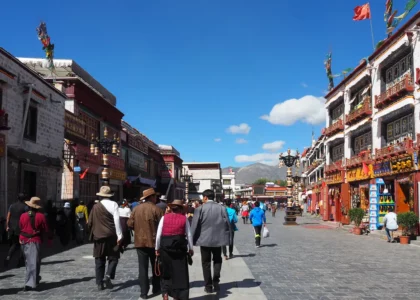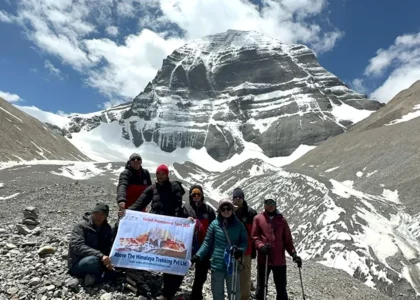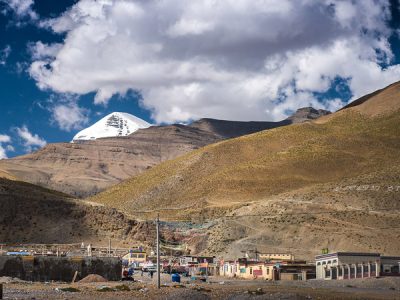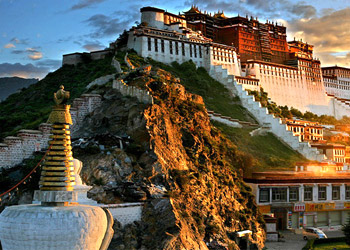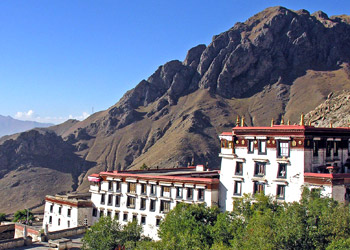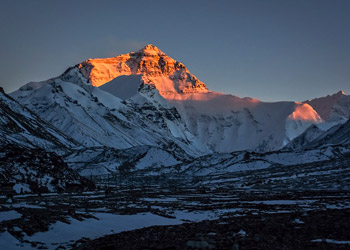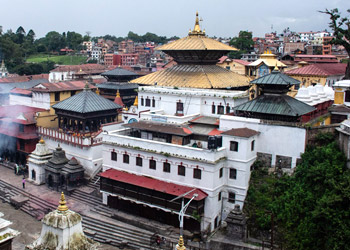Tibet
Tibet is a beautiful territory located on the highest plateau on Earth at an average altitude of over 4000 meters. This beautiful country has proved over the years its way of life has been able to withstand this influence. The power of thought and life itself overcoming the modern ravages of politics. Tibet is, without doubt, one of the most remarkable places to visit in Asia. It offers fabulous monastery sights and breathtaking high-altitude treks. The stunning views of the world’s highest mountains and one of the most likable people you will ever meet.
History
Between 1950 and 1970, the Chinese wrested control of the plateau drove the Tibetans’ spiritual leader, the Dalai Lama, and some 100,000 of this country’s finest into exile, and systematically dismantled most of the Tibetan cultural and historical heritage, all in the name of revolution.
Lhasa remains the primary focus of Buddhist worship anywhere in the world. It is a place for travelers to cast away any preconceptions and join the journey of discovery along the way, at least for a while. Monasteries have been restored across the country, along with limited religious freedoms. Your trip will take you past glittering mountain turquoise lakes and over high passes draped with prayer flags.
For many people, It is a uniquely spiritual place. Those moments of peace, fleeting and precious, when everything seems to be in its proper place, seem to come more frequently here, whether inspired by the devotion apparent in the face of a pilgrim or the dwarfing scale of a beautiful landscape.
The unique cultures and traditions of the Tibetans, Monpas, Lhopas, and Moslems and their style of extensive, exciting celebrations will keep you astonished. From the high passes ornamented with colorful flags beating endlessly against the stone cairns to the blue salt lakes of Namtso, you will travel an ancient trail alive with color, ritual, and history.
Visit the Roof of the World
Tibet is entirely within and encompasses most of the Qinghai-Tibetan Plateau or the Plateau, with an average altitude of over 4,500 meters above sea level. It is known as The Roof of the World and The Third Pole of the Globe. It is synonymous with devout religious practices, especially Tibetan Buddhism and Bon. The people living in this vast land are mainly Tibetan, an ethnic group with bold and uninhibited characteristics.
Tibetans eat beef, mutton, and dairy products as staple foods, which protect them from severe colds. They grow crops under harsh climatic conditions. The main grain crop grown here is barley. The popular Zanba and barley wine are made from it. Tibetan culture developed here, primarily isolated from the rest of the world. Human activities can be traced back to the late Paleolithic Period.
The journey to unlock the complexities posed by this arid mass of discovery (almost the size of Europe) begins with probably the most dramatic flight in the world. From Kathmandu, you will be transferred by a van/coach to Kodari (Tibet border 116 km) accompanied by our escort, and from the Tibet border onwards, Tibetan crews will drive you to Lhasa.
Tibet can be divided into the East, the South, and the North. The Eastern part is the forest region, which occupies around 25% of Tibet. The Southern part is open grassland, which occupies almost half of Tibet.
The Southern and Central regions are agricultural regions occupying the rest of Tibet and containing all the major cities: Lhasa, Gyantse, Shigatse, Gyatsa, and Tsedang. This area is also considered the cultural center of Tibet and Buddhism.
Tour in Lhasa
Spiritual traditions, temples and monasteries, lakes and rivers, and mighty snow-clad peaks are just a few of the intoxicating wonders adventurous travelers can experience when they visit this land.
Despite untold ravages during the Cultural Revolution, this country’s past grandeur, majesty, monuments & mystery remain undiminished. Visit Lhasa’s many monasteries and sites, such as the Sera Monastery and the Norbulingka, the summer palace of the Dalai Lama.
Visit the Jokhang Temple, a Tibetan spiritual center, the spectacular Potala Palace, and the Drepung Monastery. Cross the highest passes, such as Khamba La, Karo La, and Gyatmso La, which are adventurous hiking. We will visit Gyantse Dzong and Gyantse Kumbum. Lhasa offers the best view of Mt Everest from the north face and advanced base camp.
The best time to visit
You can travel here throughout the year, but mid-July through to the end of September is the best period. The temperature varies sharply from the south grassland to the north plateau. The south is warm and rainy. Most rain falls from May to September. It is warm from June to August.
The coldest months are from December to February, and crossing the passes becomes almost impossible. Below is a table of Tibet’s average temperature, rainfall, and sunshine hours. The weather is cold, harsh, and dry. You will need enough warm clothes, tennis shoes, suntan cream, sunglasses, hats, scarves, lip guards, etc.
Traveling here can be exploring ‘people’s lives in different parts of the world, seeing beautiful places, experiencing historical monuments, escaping from regular life, and experiencing adventures. Tibet can be the destination you dream of and will make your dream come true.
Visit Sera Monastery
The Sera Monastery tour is, together with Ganden Monastery and Drepung Monastery in Lhasa, known as the Three Great. Sera, in Tibetan, means “Wild Rose Garden” since opulent wild rose woods once grew around it. The Sera monastery was completed in 1419.
The monastery is magnificent and covers an area of 114,946 square meters (28 acres). Its main buildings are the Coqen Hall, Zhacang (college), and Kamcun (dormitory). Scriptures written in gold powder, fine statues, scent cloth, and unparalleled murals can be found in these halls. The Sera Monastery 4nights/5days tour also aims to raise funds for Sera Jey Monastery.
Sera temple is designed around the Main Assembly Hall, the grandest hall of Sera, which occupies a floor space of 1,000 square meters. The four-story hall has four chapels in which Arhats, Manjushri, Tsong Khapa, and Chenrezi are enshrined. During the 1959 revolt in Lhasa, Sera monastery suffered severe damage, with its colleges destroyed and hundreds of monks killed.
Visit the famous Potala Palace, the Jokhang.
The valuable Buddhist sutras that Jamchen Chojey brought back from Beijing are kept in a sutra pigeonhole adjacent to the hall. The monastery’s unique tradition and philosophical curriculum attract hundreds of pupils each year, and it is presently recognized as one of the world’s largest and premier Buddhist monastic institutes.
The Sera Monastery tour is a fine introductory tour to the heart of this country. You start by flying over the Himalayas from Kathmandu to Lhasa and touring this ancient Buddhist capital. You first visit Potala, a splendid summer palace of the Dalai Lama.
Visit the famous Potala Palace, the Jokhang, and great monasteries and walk through the bustling Barkhor Market. Visitors who go to the Sera monastery are very interested in debating the Buddhist Docdoctrineshe Sera Bengqin Festival, a grand festival held in the Sera Monastery on December 27 of the Tibetan calendar (about February in the Gregorian calendar). The Norbulingka Palace (summer palace of the Dalai Lamas), along with a round of the Sera monastery, is the other highlight of this Sera and Drepung monastery tour in Tibet package.
Lhasa Everest base camp trekking
It is the most popular trekking destination in Tibet. Most of Tibet’s territory is covered by high mountains above 4,000 meters, which has earned the region the nickname “The Roof of the World.” The Tibet Lhasa Everest base camp tour offers superb Himalayan scenery, including Mt. Everest, 8848m.
The beautiful landscape and Tibetan monasteries include Lhasa Potala Palace, Drepung Monastery, etc. The Everest Base Camp Trekking is a journey of a lifetime. You will also explore and experience the unique Tibetan culture, brown rolling hills, and wrecked forts.
The artistic monasteries and centuries-old caravan trails. Exploration of the Everest base camp from Lhasa is uncovering the mysterious Buddhist Kingdom of Tibet, which is still a mystery for foreigners.
Everest base camp trekking via Tibet trip starts with a scenic flight to Lhasa. It also offers magnificent views of Everest (8848m), Kanchenjunga (8536m), and other Himalayan peaks. Spend two days exploring the Lhasa city.
We will visit Lhasa’s many monasteries and sites, such as the Sera Monastery and the Norbulingka, the Dalai Lama’s summer palace. We will also visit the Jokhang Temple, a Tibetan spiritual center, the spectacular Potala Palace, and the Drepung Monastery.
Enjoy the highest passes of Khamba La, Karo La, and Gyatmso La.
The Tibet EBC camp tour continues through the valleys of Gyantse, Shigatse, Sakya, Shegar, and Dingri to the Everest base camp. On the way, we will cross the highest passes, Khamba La, Karo La, and Gyatmso La, which are adventurous hiking. We will visit Gyantse Dzong and Gyantse Kumbum. We also pass High Mountain passes, beautiful Tibetan villages, and colorful slopes of the Tibetan hills.
Following five days of the Everest Base camp, trekking from Tibet is walking to the Base camp—Trek along the Ra Chhu stream beyond Chholling and past the village of Lungjhang. We climb over Lamna La with Gyachung Kang and Cho Oyu off to the south and descend to Zommug, the highest permanent settlement in the Everest region. On the path, we are rewarded with uninterrupted views stretching from Makalu to Shishapangma, with clear views of Everest as we turn into the Rongbuk Valley.
Arriving at Everest Base Camp and being face-to-face with ‘Chomolungma’ north face (the Tibetan name for Everest) is this trek’s most breathtaking moment. Then, we return to our path to Zhangmu for the journey back to Kathmandu Valley.
Lhasa Everest base camp trekking in Tibet is for those in good health who enjoy hiking and traveling and don’t have any underlying health issues that might be worsened by spending nights at high altitudes. A trip to significant places of interest in Tibet comprises cultural, historical, and natural attractions, and the outstanding Everest base camp trek is full of astonishing possessions.
Simikot Kailash Lhasa trekking
This trek offers superb Himalayan scenery, including Mt. Everest, Holy Himalaya Mt. Kailash, ancient cities, lush valleys, beautiful landscapes, and Tibetan monasteries. This Tibet Simikot Kailash Lhasa tour will offer excellent trekking fluency, which takes you to Tibet’s mythical Mount Kailash and Lake Mansarovar via the hidden upper Humla valley in Nepal’s westernmost Tibetan frontier.
Simikot Kailash Mansarovar’s trekking tour in Nepal-Tibet offers an excellent opportunity to experience ancient Tibetan culture and tradition. The tour travels through the beautiful mountain area, past typical villages, along rivers, and across the highest passes.
Nepal Simikot Kailash trek tour’s legendary reputation draws pilgrims from throughout Asia to walk the sacred path around the earthly incarnation of the mythical Mount Meru and Lake Mansarovar.
Kailash Mansarovar Yatra via Simikot starts with a flight from Kathmandu to Nepalgunj, which offers good views of the Himalayas. Early the following day, we fly north to Simikot, the headquarters of Nepal’s most remote district, Humla. We ascend to a pleasant forest ridge above the town of Simiko. From here, we continue through the jungle and villages along the Karnali River toward Dhara Pokhari.
We’ll visit the Norbulingka, the summer palace of the Dalai Lama. We follow the Humla Karnali basin to Kermi. Crossing the Salli La Pass and walking along a relatively flat terrain, we arrive at Yalbang. We reach Mansarovar by passing the small villages of Munchu, Yari, sip, and Hilsa.
En route, we visit the Dhungkar Choezam Monastery, crossing Thado Dhunga (4043m). We will also reach the base camp for the Nara la pass (4580m). It offers incredible views of the Tibetan Plateau before arriving at the Ranipauwa village and crossing the Nepal-China (Tibet) border.
Kailash Mansarovar Tour from Simikot
The drive through green pastures and huge valleys gives way to the first sighting of Mt Kailash and Lake Mansarovar. Mansarovar is the most venerated of Tibet’s many lakes. Explore the Garuda Valley, which contains mysterious caves, some of which have never been explored.
After the Simikot Mansarovar tour, we drove to Tarboche, the starting point of the Five Days of Kora of Mt. Kailash. We walked up the Lha Chu Valley through beautiful green meadows and streams, with Mt. Kailash towering above us. We reached Dirapuk, with a fine view of the north face of Mount Kailash.
It’s an arduous climb to the summit, where you can see one of the highest lakes in the world, Thukpe Dzingbu Lake, known as the Lake of Compassion. The lake descends to Dzutul-puk. There is a monastery, several meditation caves, and a cave containing an image of Milarepa. You will pass by the small towns of Zhongba and Paryang.
Today, we continue driving along a stretch of road, passing through the small, dusty town of Zhongba, Saga, en route to Shigatse. We will visit Gyantse Dzong and Gyantse Kumbum at Gyantse while visiting the Tashilhunpo Monastery.
The following two days of the Simikot Kailash Lhasa tour are spent exploring Lhasa City. We will visit Lhasa’s many monasteries and sites, such as the Sera Monastery and the Norbulingka, the summer palace of the Dalai Lama. We will also visit the Jokhang Temple, a Tibetan spiritual center, the spectacular Potala Palace, and the Drepung Monastery. The Simikot Mt. Kailash Mansarovar trekking trail ends with a journey back to Kathmandu.
This Simikot Kailash trekking tour is highly recommended to those keen to experience Tibetan Buddhists’ traditional Buddhist culture, tradition, and lifestyle. Simikot Mansarovar’s tour is truly the trip of a lifetime with stunning scenery and cultural highlights.
Birdwatching
The “Roof of the World” is one of the most noteworthy places on Earth and offers fantastic cloister sights and stunning high-elevation treks. The shocking perspectives of the world’s most remarkable mountains and a percentage. They are the friendliest individuals anywhere on the planet and also a superb spot for a birdwatching tour.
Tibet has over 488 bird species and about 18 nature reserves. Five of these are National Nature Reserves in which uncommon and valuable creatures are protected. There are also more than 2,300 types of insects and 64 types of fish.
There are 45 species of amphibians, and 55 types of reptiles are also found there, taking after what Nature Reserves are famous for—the Qiangtang Nature Reserve for Wild Tibetan Yaks and Black-necked cranes, Asses, and Gazelle.
The Markam Nature Reserve for Yunnan Snub-nosed Monkey. The Shenzha Nature Reserve is for black-necked cranes. Nyingchi-Dongjug Nature Reserve for Antelopes. The Riwoge-Chamoling Nature Reserve for Red Deer.
Snow pigeons, Tibetan Pheasants, and Black-necked cranes are uncommon winged creatures to watch in Tibet. Key ornithological attractions incorporate the Tibetan-eared bird and Derbyan Parakeet. There is also the Black-necked Crane, Tibetan Blackbird, Brown-cheeked Laughingthrush, and Giant Babax.
Book with Confidence
- Flexible bookings and easy trip date changes
- Personalized service and customized group sizes
- Safe travels with owner-operated services and highly experienced guides
- Best price guarantee for the most value for your money
- Secure & easy online booking
 Have Questions?
Have Questions?Talk to Expert
Meet Mr. Puru Timalsena, Nepal's best trek and tour organizer, who has been working in the Himalayas for more than 15 years.
WhatsApp/Viber +977 98510 95 800
